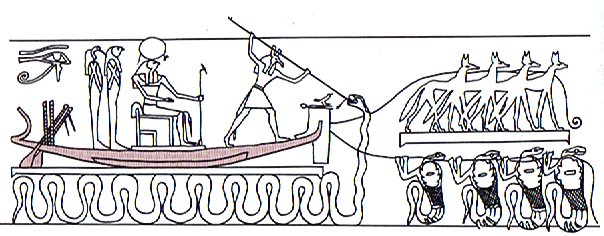|
TRANSLATIONS
There are very many possible routes to choose among when travelling in this maze. To complicate matters even more I think Nga Kope Ririva, the three rocks outside the southwest corner of the triangular island, unavodiably must be the three 'stones' associated with the 'turtle'. In the sacred geography of Easter Island the beginning must be here. The kuhane went here before setting foot on the mainland, and a zero (an egg) therefore became the ordinal number of Nga Kope Ririva. It does not belong to the 'carapace'. The three 'eggs' of the 'turtle' should be produced through the opening at the back of the 'old turtle'. Though the Mayas let the new generation appear through a crack in the shell of their turtle. 0 Nga Kope Ririva ought to be mapped onto spring, when manu tara announced the arrival of a new sun. A sea swallow seems to be exactly on the point - because the new sun arrives over the sea and because he must in some mysterious way be carried by the swallow. Instead of a being carried inside a fish - as we have seen in G - it is a being in the sky which arrives with the sun. A sea swallow has swollen the infantile sun. The swallow is a messenger of the arriving summer. He lives on insects. In a way manu tara must be Haga Takaúre. It could be argued that the new sun arrives in a canoe moving across the sky, he does not need to be protected from the water of the sea - which is necessary if he comes from an indundate region. He does not need to be swallowed. In ancient Egypt - whose peoples were keen observers and full of common sense - the swallow travelled at the front of the ship of the Pharaoh (sun), a swallow cannot swallow a king: ... relighting points of time are symbolized by manu tara, daybreak birds. In Wilkinson this picture is illuminating:
According to Wilkinson the barn swallow (Hurundo rustica) sitting foremost on the sunboat (travelling under the earth) is there to greet the morning sun's reappearance in the east ... But if the sun is still in his 'spiritual' stage, like an flying insect, the swallow may hunt him and force him to metamorphose into next stage. ... Braiding their hair, she breathed upon them such a wondrous perfume that when they returned and Astarte saw and smelt the braids she sent for the stranger, took her into the house, and made her the nurse of her child. The great goddess gave the infant her finger instead of breast to suck and at night, having placed him in a fire to burn away all that was mortal, flew in the form of a swallow around the pillar, mournfully chirping ... ... The four bereaved and searching divinities, the two mothers and their two sons, were joined by a fifth, the moon-god Thoth (who appears sometimes in the form of an ibis-headed scribe, at other times in the form of a baboon), and together they found all of Osiris save his genital member, which had been swallowed by a fish ... In G the end of takaure is located later than at the beginning of summer:
'Summer' I now defined as the time described by the periods which are ending in the way exemplified by Ga4-4. It is not the time which I have referred to as 'high summer', defined by mago and 'humpback':
The concept of a 'high summer' originated from the parallel K text, with twice 26 glyphs from Ka4-15 up to *Kb1-15:
Maybe sun is 'incorporated' in the two fat henua signs? The season cannot be the middle of summer, it must be a part of the 1st half of the year, because we have identified summer solstice at Gb1-6:
Let us once again map the major stations in G. We begin with Hanga Te Pau and we must use that glyph as our fixed point:
Ga4-2 comes as glyph number 84 beyond Ga1-1, which maybe should not be counted. It is a special character. If we do not count it, we could refer it to the preceding cycle, adding it to 471 and reach 472 = 4 * 118 = 8 * 59. But we must count it in order to reach Gb5-12 at 365. The conclusion is that there must be different ways to count depending on whether you count the journey of the sun over the year or whether you have moon in sight. Ga4-2 is also the 59th glyph beyond Ga1-26, and Ga4-2 appears to be a cardinal point. According to the text in G we presumably can regard it as marking Haga Takaúre. 365 - 85 = 280 = 10 * 28, and beyond Ga4-2 sun therefore must arrive. Whatever made the creators of Manuscript E locate Hanga Takaure in the middle of the 2nd quarter it is not a 'true' picture mythically seen:
Presumably they looked at the spatial geography, where Haga Takaúre is closer to Poike than Tama. With 84 = 3 * 28 (an equation we should trust because there are 3 feathers at left in Ga4-2), the 'carapace of the sun' will measure 84 + 280 = 364 days. 24 stations with 15 days in each (instead of 13 months with 28 days) necessarily forces some changes in the locations but not so great as to explain why Hanga Takaure should be immediately before Poike. The explanation must rather be a different definition of what Hanga Takaure means. If the year once began somewhere east of Vinapu and if later manu tara moved its beginning to Nga Kope Ririva, a once properly located Hanga Takaure would be dislocated far towards midsummer. The text in G seems to follow such an old map rather than that of manu tara. |
|||||||||||||||||||||||||||||||||||||||||||||||||||||||||||||||||||||||||||||||||||||||||||||||||||||||||||||||||||||||||||||||||||||||||











